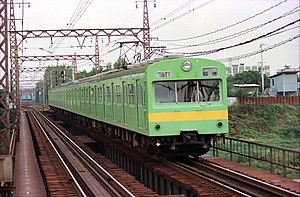You can help expand this article with text translated from the corresponding article in Japanese. (July 2022) Click [show] for important translation instructions.
|
| 101 series | |
|---|---|
 JNR 6-car set at Asaka Station on the Hanwa Line, 1978 | |
| In service | 1957–2003 |
| Replaced | 72 series |
| Constructed | 1957–1969 |
| Entered service | December 1957 |
| Scrapped | 1987–2014 (not all parts are fully scrapped, other remaining parts such as pantographs are still in use in other rolling stocks such as 121 series/7200 series[1] & remodeled 145 series converted from old 101 series EMUs) |
| Number built | 1,535 vehicles |
| Number in service | None (44 vehicles being converted into 145 series multiple locomotive) |
| Number preserved | 2 vehicles |
| Number scrapped | 1,489 vehicles |
| Successor | 103 series, 205 series, 207 series |
| Formation | 2, 3, 6, 7, 8 or 10 cars per trainset |
| Operators | JNR (1957–1987) JR East (1987–2003) JR-West (1987–1992) Chichibu Railway (1986–2014) |
| Specifications | |
| Car body construction | Steel |
| Car length | 20,000 mm (65 ft 7 in) |
| Width | 2,879 mm (9 ft 5.3 in) |
| Doors | 4 pairs per side |
| Maximum speed | 100 km/h (62 mph) |
| Traction system | Resistor control |
| Traction motors | MT46 |
| Power output | 100 kW (134 hp) |
| Acceleration | 2.0 km/(h⋅s) (1.2 mph/s) (7-car formation) 3.2 km/(h⋅s) (2.0 mph/s) (all motored cars) |
| Deceleration | 3.0 km/(h⋅s) (1.9 mph/s) (service, 7-car set) 3.5 km/(h⋅s) (2.2 mph/s) (emergency) |
| Electric system(s) | 1,500 V DC overhead catenary |
| Current collector(s) | Pantograph |
| Bogies | DT21, DT21T, TR64 |
| Track gauge | 1,067 mm (3 ft 6 in) |
The 101 series (101系, 101-kei) was a DC electric multiple unit (EMU) commuter train type introduced in 1957 by Japanese National Railways (JNR), and formerly operated by East Japan Railway Company (JR East) and West Japan Railway Company (JR-West). The last remaining trains were withdrawn in November 2003.
- ^ Fukuhara, Shunichi (September 2016). 121系近郊形直流電車のあゆみ part2 [The history of the 121 series suburban DC EMU trains (part 2)]. Japan Railfan Magazine (in Japanese). Vol. 56, no. 665. Japan: Koyusha Co., Ltd. pp. 94–99.